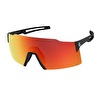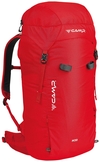Dhaulagiri 2005: lightening at altitude
The Dhaulagiri 2005 expedition comprised of Romano Benet, Nives Meroi and Luca Vuerich forced to descend due to a storm at 7000m. Ed Vierstus currently on Annapurna summit push.
 Terrible weather in the Himalaya, between Annapurna and Dhaulagiri. An intense storm, with thunder and lightening at 7000m (!) has forced the Italian trio Romano Benet, Nives Meroi and Luca Vuerich into an electric descent on Dhaulagiri, while the Italian Ragni di Lecco expedition members (Panzeri, Merelli e Bernascone), together with Ed Vierstus and others, are currently pushing towards the summit of Annapurna despite high winds... The team at Dhaulagiri is waiting for conditions to improve to attempt another summit push. One thing is certain: the weather during this pre-monsoon season has been terrible so far. have you ever heard of thunder and lightening at 7000m? LIGHTENING AT ALTITUDE BY Nives Meroi 7 May – Base Camp. The forecast "promises" a slight improvement: dropping winds and relatively good weather. Tomorrow we depart to try and reach the summit, the right one this time. 10 May – 6800m. After having left our tent at 6300m at 8.00 am this morning, the weather was relatively good with light winds. As we progressed the weather closed in and it started to snow, and now we're here, buried in a crevace thinking about what ro do next. Last time we came here, when we reached the "Italian summit" as we have jokingly called it, the weather up to 7300 was similar. But now it's getting worse by the minute. The fixed ropes up the snow and rock arete are just above us, leading up to our camp 2. it's snowing hard and visibility is poor; Luca and I decide to "start walking". We jump out of the crevasse, move onto the arete, and attach our jumars to the rope. Above our heads, a crackle, an aurora. We immediately realise what's happening: lightening. The air is filled with electricity. We leap back into the crevase. And now? What next? First of all we have to wait to see if the storm passes, to then decide whether to continue, descend to BC, to return to Camp 1 and wait for a day. Romano pokes his head into the cravasse: "the weather is getting worse. We've got to make a decision." The storm shows no sign of moving on, about 30cm of fresh snow has already fallen and visibility is practically nill, down to about 5/6m.  We have to descend. The first 500m are relatively easy to understand, even though we're "blinded" by the cloud: a long snowy, not too steep crest. Soon we realise what the main problem is: lightening once again. Auroras around our heads, a strange tingling sensation in our hands as we grasp the ice axes, and a bitter sulphur-like taste in our mouths. We race down for a couple of meters and when the atmosphere is too laden we throw ourselves onto the ground, hurl the ice axes away and wait for a bit; we then get up and descend a few more meters before crouching down once more. At the end of the crest we have to move right along the long plateau with leads to the col at 5800m and, in the middle of some crevasses, our Camp 1. Moving off the crest we should be less exposed to lightening strikes, but here we are faced with other problems: we risk setting off an avalanche or getting lost on our way down. The clouds are thick and we have no reference point, so we descend using our intuition: one person descents and just as he disappears in the fog the second starts off. Beneath our feet the noise of a breaking windslab , we move away to avoid setting off an avalanche. The thunder is audible a long way off, but we feel the tension and tiredness. We find out tent at 6300,m, guess our way through the crevasses and finally reach the col at 5800m From here all we have to do is find the snowbridge that crosses the crevasse, descend onto the plateau, through the icefall and cross the glacier to reach base camp: just a couple of hours is all we need. We radio Leila who is waiting for us at BC. The situation there isn't much better: the wind has almost ripped away our mess tent. We descend rapidly, it's snowed less here. After some difficulties at the end of the plateau, where we get lost in the crevasses due to poor visibility, we finally reach BC at about 16.00; tired, exhausted and frozen. by Nives Meroi 
Photos: Storm at 6800m on Dhaulagiri; Luca Vuerich and Romano Benet; Camp 1. (Photos Luca Vuerich). | ||||||||||||
Latest news
Expo / News
Expo / Products
Waterproof thanks to HDry technology and crampon-compatible, the Dynafit WP Elevation is the lightest mountaineering shoe on the market.
Revolutionary mountain hiking shoes.
Nubuck leather mountaineering boots.
Scott Stride sunglasses with maximal field of vision, thanks to its toric lens.
A lightweight, stretchy, and comfortable T-shirt.
Light Backpack for alpinism with removable lid featuring a large main compartment



 Copia link
Copia link
























